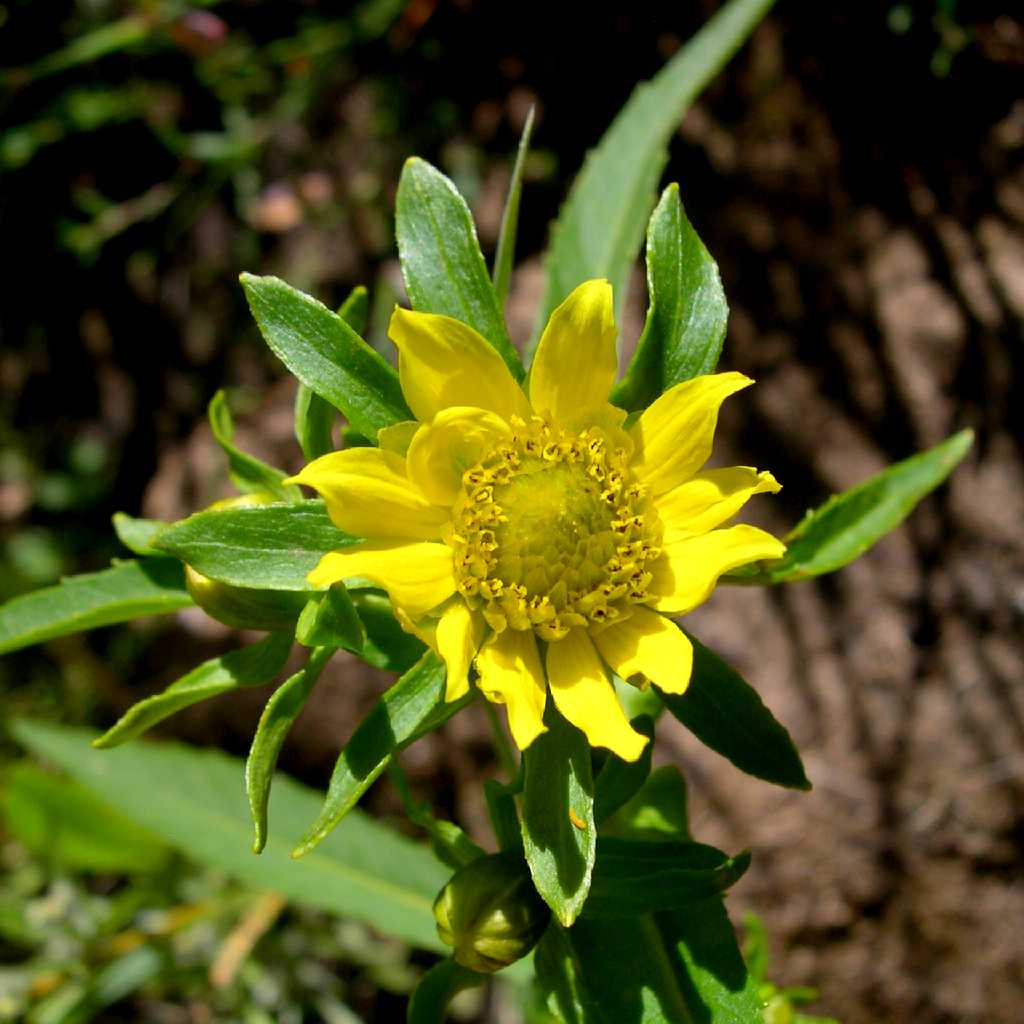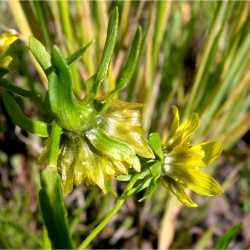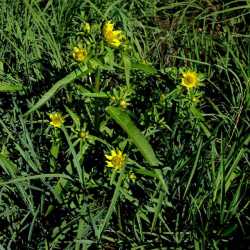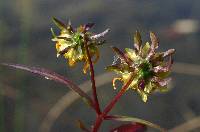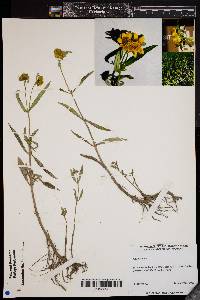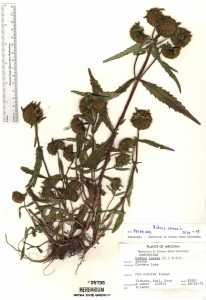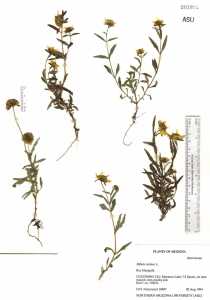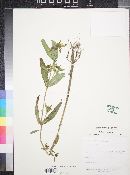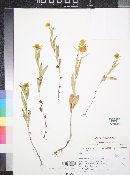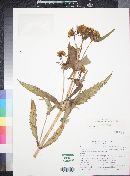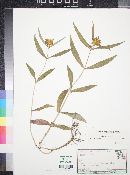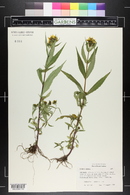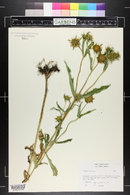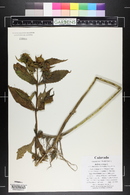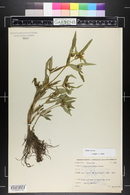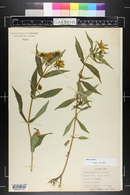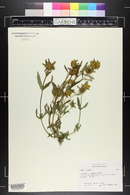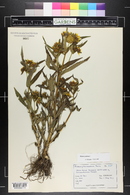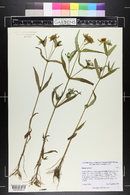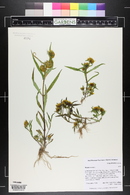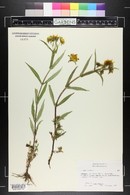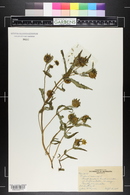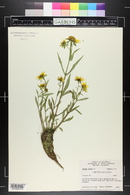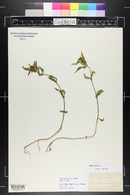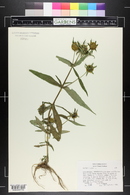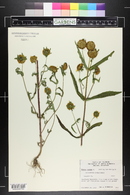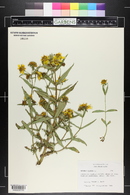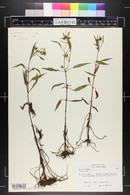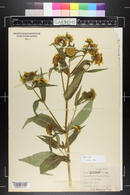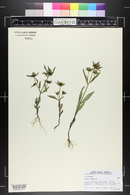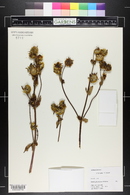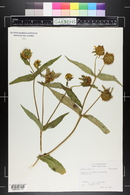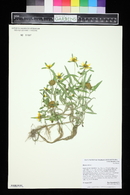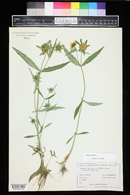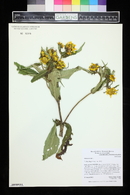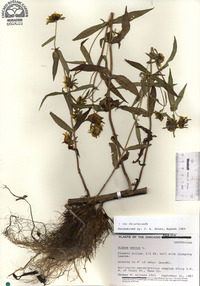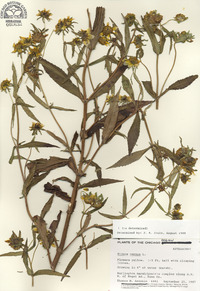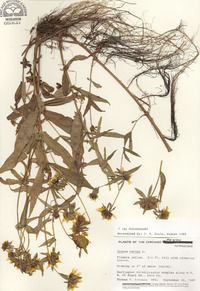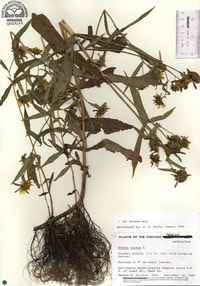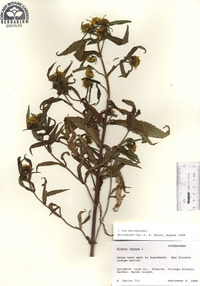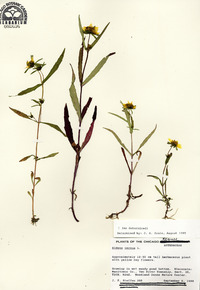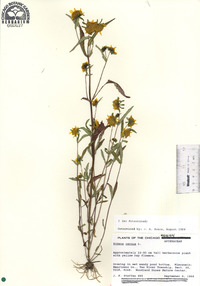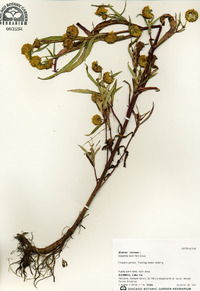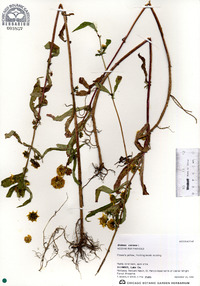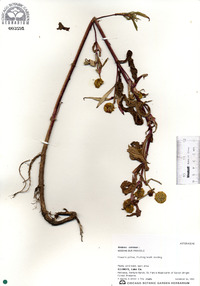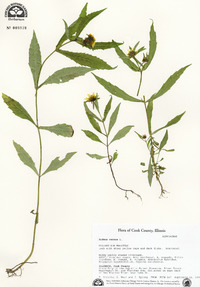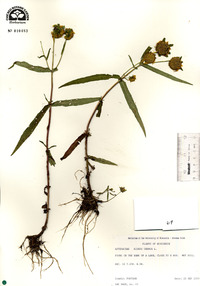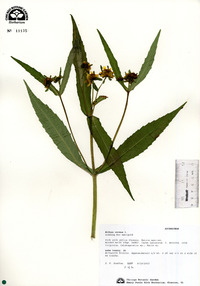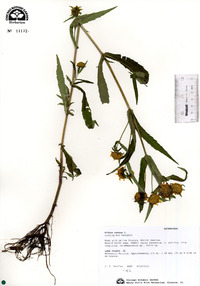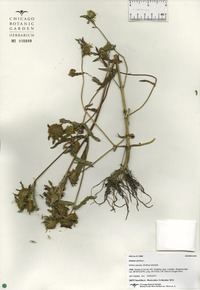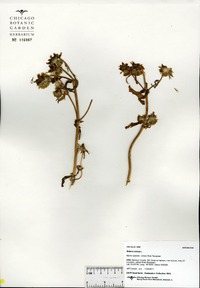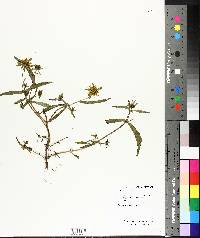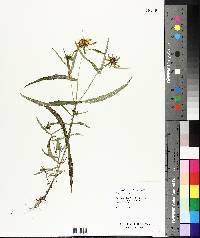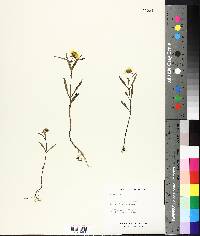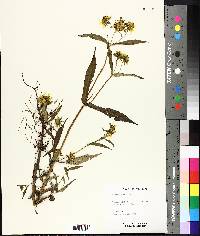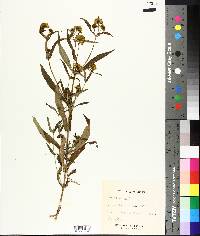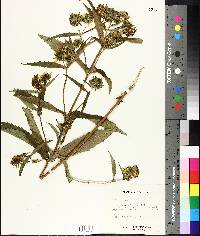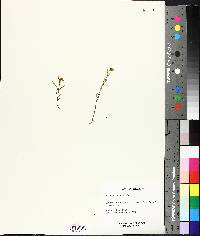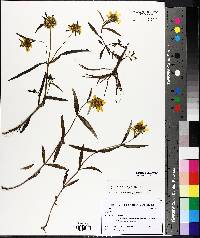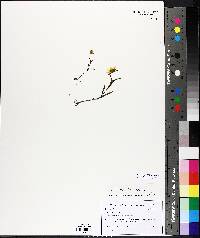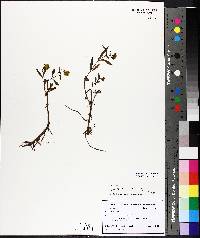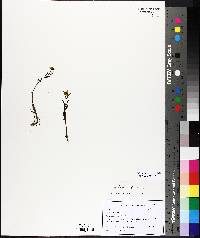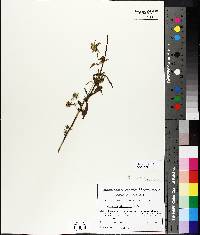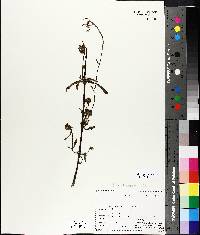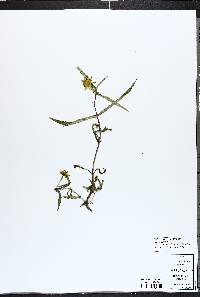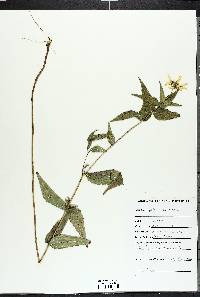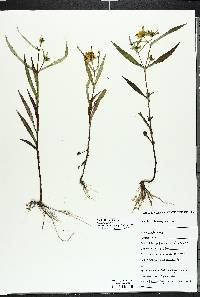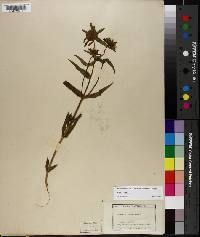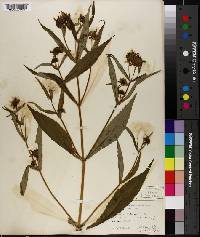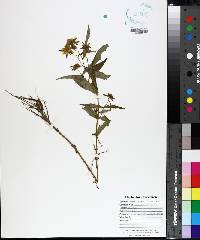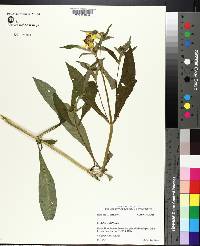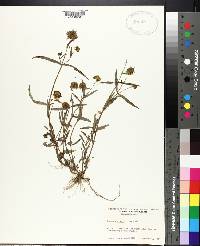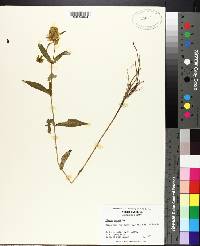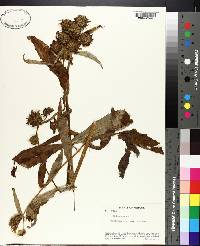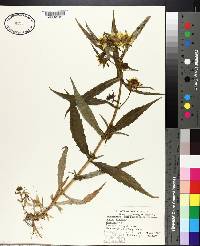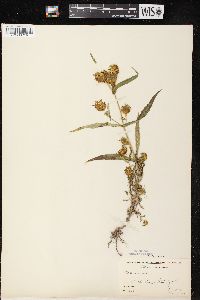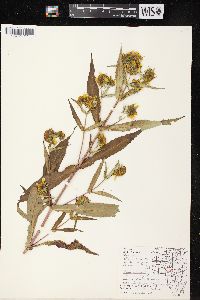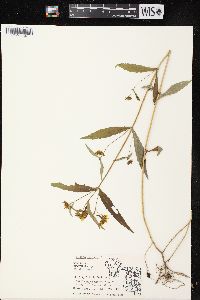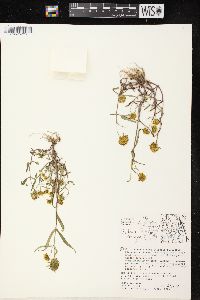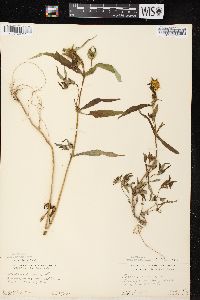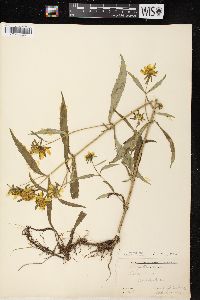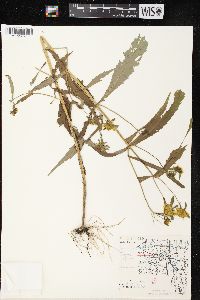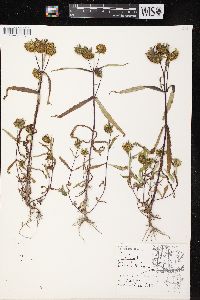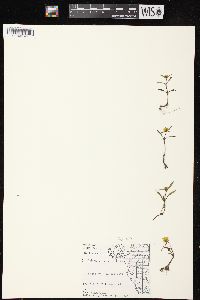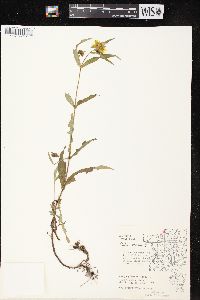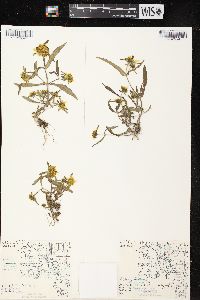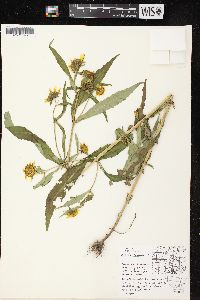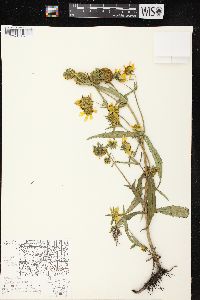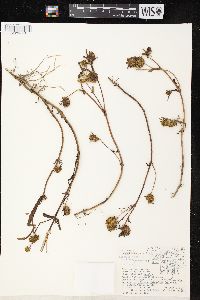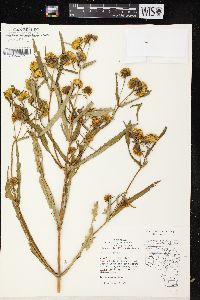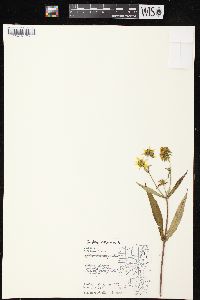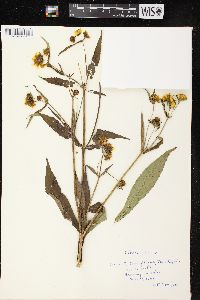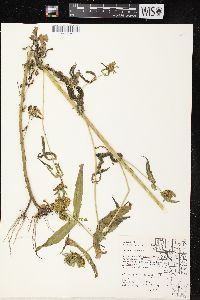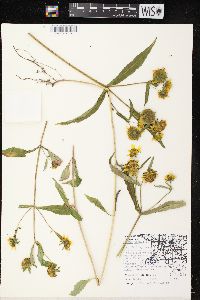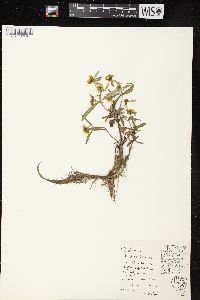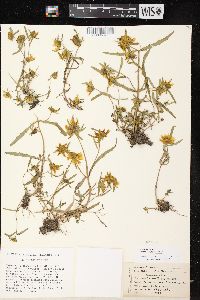
|
|
|
|
Family: Asteraceae
Nodding Burr-Marigold
[Bidens cernua f. minima (Huds.) Neuman, moreBidens cernua var. dentata (Nutt.) Boivin, Bidens cernua var. elliptica Wieg., Bidens cernua var. integra Wieg., Bidens cernua var. minima (Huds.) Pursh, Bidens cernua var. oligodonta Fern. & St. John, Bidens cernua var. radiata Dc., Bidens filamentosa , Bidens glaucescens Greene, Bidens gracilenta , Bidens leptomeria , Bidens macounii Greene, Bidens prionophylla , Coreopsis bidens] |
Annuals, (2-)20-100(-400+) cm (stems sometimes rooting at proximal nodes). Leaves (rarely in 3s) sessile; blades lance-ovate or oblanceolate to lanceolate or linear, 40-100(-200+) × (2-)5-25(-45+) mm, bases cuneate to rounded, margins usually coarsely dentate to serrate, sometimes entire, sometimes ciliate, apices acute to acuminate, faces glabrous. Heads (erect or nodding at flowering, usually nodding in fruit) borne singly or in open, ± corymbiform arrays. Peduncles 10-40(-100+) mm. Calyculi of (3-)5-8(-10) spreading to reflexed, oblong to lance-linear, often ± foliaceous bractlets or bracts (3-)8-12(-25+) mm, margins usually ciliate, abaxial faces usually glabrous, bases sometimes hispidulous. Involucres ± hemispheric or broader, (3-)6-10 × (8-)12-20+ mm. Phyllaries 6-8+, ovate or lance-ovate to lanceolate, 2-10 mm. Ray florets usually 6-8, sometimes 0; laminae orange-yellow, 2-15(-18) mm. Disc florets (10-)40-100(-150+); corollas orange-yellow, 3-4 mm. Cypselae blackish or brown, usually ± flattened, sometimes ± 4-angled, ± cuneate, outer (3-)5-6+ mm, inner 4-8 mm, margins (± thickened or winged) retrorsely ciliate, apices ± truncate to convex, faces ± striate, glabrous or tuberculo-strigillose; pappi of (2-)4, ± erect, retrorsely barbed awns (1-)2-4 mm. 2n = 24, 48. Flowering late (Jul-)Aug-Sep(-Oct). Swamps, marshes, peat and sedge bogs, flood plains; 0-2300 m; Alta., B.C., Man., N.B., N.W.T., N.S., Ont., P.E.I., Que., Sask., Yukon; Ala., Alaska, Ariz., Ark., Calif., Colo., Conn., Del., D.C., Ga., Idaho, Ill., Ind., Iowa, Kans., Ky., La., Maine, Mass., Mich., Minn., Mo., Mont., Nebr., Nev., N.H., N.J., N.Mex., N.Y., N.C., Ohio, Okla., Oreg., Pa., R.I., S.Dak., Tenn., Tex., Utah, Vt., Va., Wash., W.Va., Wis., Wyo.; Europe, Asia. Bidens cernua is used medicinally to treat urinary-tract infections.
FNA 2006, Heil et al 2013, Welsh et al 1987 Duration: Annual Nativity: Native Lifeform: Forb/Herb General: Annual herbs 20-100 cm tall; stems decumbent to erect, commonly branching near the base, sometimes rooting at proximal nodes. Leaves: Opposite, sessile to subclasping; blades lance-ovate to lanceolate or linear, 4-10 cm long, 0.5- 2.5 cm wide, with tapering or rounded bases, acute to acuminate apexes, margins that are usually coarsely dentate to serrate but sometimes entire or ciliate, and both surfaces glabrous. Flowers: Flower heads erect or nodding in flower and always nodding in fruit, radiate or sometimes disciform, on peduncles 1-10 cm long, solitary or in loose, flat-topped panicles; calyculi (extra set of bracts just below the involucre) of 5-8 oblong to lance-linear bracts, spreading to reflexed, leafy, 1 cm long; involucre (the ring of bracts wrapped around the flower head) hemispheric or broader, 6-10 mm long, 1-2 cm wide, the bracts (phyllaries) 6-8, ovate to lanceolate, 2-10 mm long, with yellow tips; ray florets usually 6-8, sometimes absent, corolla laminae (ray petals) orange-yellow, 2-15 mm long; disc florets 40-100, corollas orange-yellow, 3-4 mm. Fruits: Achenes blackish or brown, flattened or 4-angled, 4-8 mm long, striate, glabrous or tuberculo-strigillose; with a pappus of 4 (occasionally 2 or 3) erect, retrorsely barbed awns, those 2-4 mm long. Ecology: Found in marshes, wet meadows, and flood plains; elevation range in the Southwest is 4,500-7,500 ft (1372-2286 m); flowers July-September. Distribution: Widely distributed in the northern hemisphere; in Europe, Asia, and N. Amer; in all Canadian provinces and every US state except FL. Notes: Bidens is a genus of herbaceous plants with opposite leaves, discoid or radiate flower heads with yellow-orange flowers, and seeds (achenes) with 2-4 barbed awns. B. cernua is a widespread species of wetlands, distinguished by its simple, sessile leaves with teeth on the edges; flower heads that nod or droop when fully mature; and 4 awns on each seed (occasionally fewer awns). Quite similar to the regionally more common B. laevis, but that species has usually erect flower heads and larger ray petals, 15-30 mm long. B. cernua is relatively uncommon in AZ and NM, present mainly in the northern parts of both states, primarily in the White Mountains, San Francisco Peaks and Colorado Plateau, and Southern Rockies. Ethnobotany: Used medicinally to treat urinary-tract infections. Etymology: Bidens is derived from the Latin bis, twice and dens, tooth, hence meaning 2-toothed, referring to the pair of awns on the seeds of many Bidens spp; cernua means drooping or nodding, referring to the flower heads in fruit. Synonyms: Bidens glaucescens, Bidens cernua var. dentata, Bidens cernua var. elliptica, Bidens cernua var. integra, Bidens cernua var. minima, Bidens cernua var. oligodonta, Bidens cernua var. radiata, Bidens cernua var. cernua Editor: AHazelton 2015 Annual 1-10(-40) dm, glabrous or the stem scabrous-hispid; lvs sessile, often basally connate, simple, lance-linear to lance-ovate, coarsely serrate to subentire, 4-20 x 0.5-4.5 cm; heads hemispheric, many-fld, the disk 12-25 mm wide, commonly nodding at least in age; outer invol bracts 5-10, lance-linear, unequal, usually rather leafy and spreading, commonly surpassing the disk; rays (6-)8, yellow, to 1.5 cm, or none; receptacular bracts thin and soft, mostly yellowish at the blunt tip; disk- corollas mostly 5-lobed; anthers shortly exserted; achenes 5-8 mm, the margins tending to be thickened, cartilaginous, and pale at maturity, as also the finally convex (broadly dome-shaped) summit; pappus of (2-)4 retrorsely barbed awns; 2n=24. Low, wet places; widespread in temp. parts of the N. Hemisphere, and throughout our range. Aug.-Oct. (B. elliptica; B. filamentosa; B. glaucescens; B. gracilenta; B. leptopoda; B. prionophylla) Gleason, Henry A. & Cronquist, Arthur J. 1991. Manual of vascular plants of northeastern United States and adjacent Canada. lxxv + 910 pp. ©The New York Botanical Garden. All rights reserved. Used by permission. From Flora of Indiana (1940) by Charles C. Deam More or less frequent in the northern part of the state and becoming infrequent to rare south of the lake area. It is found in wet places in marshes, in bogs and ditches, and on the borders of lakes, rivers, creeks, ponds, and swamps. On the whole, this species prefers a wetter and more springy habitat than the next two species [Bidens comosa and Bidens connata]. The leaves are variable in their shape and in the number and length of the teeth of their margins. Some authors have segregated these variations as varieties but I have not thought them worthy of naming. ...... Indiana Coefficient of Conservatism: C = 2 Wetland Indicator Status: OBL |
This project was made possible in part by the Institute of Museum and Library Services [MG-70-19-0057-19].
Powered by Symbiota

